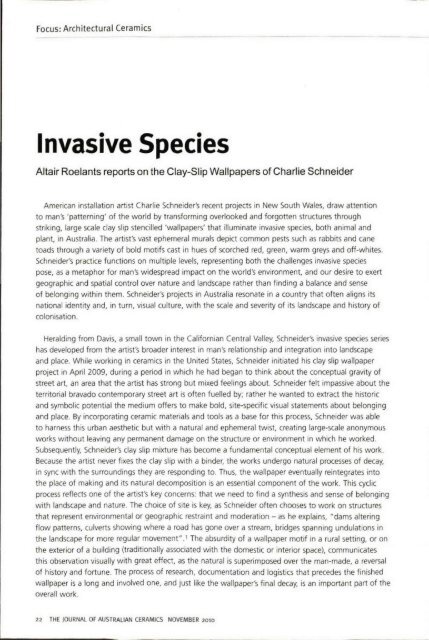The Journal of Australian Ceramics Vol 49 No 3 November 2010
Create successful ePaper yourself
Turn your PDF publications into a flip-book with our unique Google optimized e-Paper software.
Marea Gazzard, Two Containers, 1959<br />
Photo: Don Gazzard<br />
Giurgola, one <strong>of</strong> the architects <strong>of</strong> the new <strong>Australian</strong> Parliament House. This article, first published in<br />
1984 and now reprinted in this issue <strong>of</strong> <strong>The</strong> <strong>Journal</strong> <strong>of</strong> <strong>Australian</strong> <strong>Ceramics</strong>, gives an insight into how<br />
one <strong>of</strong> this country's leading architects sought to incorporate the work <strong>of</strong> <strong>Australian</strong> craftspeople into<br />
the very fabric <strong>of</strong> this important building (if that isn't mixing metaphors) right from the planning stages. '<br />
On a more intimate scale, the interiors <strong>of</strong> 1960s architect-designed modernist houses, with an<br />
emphasis on natural surfaces largely free from overt ornamentation, provide a wonderful setting for<br />
ceramics <strong>of</strong> the period. <strong>The</strong>re is a certain 'rightness' in seeing stoneware ceramics displayed in this<br />
setting, whether as tiles, functional pottery or decorator pieces.<br />
For example, in the ceramics <strong>of</strong> Marea Gazzard one sees a soph isticated take on the vessel as<br />
domestic sculpture. Before studying in Europe in the 1950s, Marea Gazzard, who was married to the<br />
architect Don Gazzard, had been exposed to the work <strong>of</strong> avant-garde British ceramic artists like Lucie<br />
Rie in the pages <strong>of</strong> influential architectural magazines like Domus. In England she had contact with Rie,<br />
as well as with the work <strong>of</strong> the artists Nicholas Vergette and Ha ns Coper, and it was Coper's work in<br />
particular that deeply informed Gazzard's ceramics on her return to Australia in 1960.<br />
At the time, only a few <strong>Australian</strong> potters were experimenting with forms beyond the purely<br />
functional. It is true that many potters had made smaller scale sculptural pieces - John Percival's famous<br />
Angel works are a good example - but it is a mistake to confuse this work with ceramics which have a<br />
more direct connection to architecture.<br />
<strong>The</strong>se connections are sometimes obvious, as in the incorporation <strong>of</strong> ceramics into a building or<br />
its surrounds; at other times they are more indirect. Sometimes it is just a question <strong>of</strong> scale, as when<br />
the Austrian-born sculptor Bert Flugelman collaborated with Les Blakebrough on large scale ceramic<br />
sculptures that were made and subsequently exhibited at the Sturt Workshops in Mittagong. To pick a<br />
20 THE JOURNAL Of AUSTRALIAN CERAMICS NOVEMBER <strong>2010</strong>


















